Whether you’ve been a collector all your life, or you just decided recently that antiques are your thing, you will eventually run across Flow Blue china. However, what is blue flow china, and when was it originally made?
Flow Blue china is a type of collectible ceramic china originating from early 19th century England. It is unique because of the process that was used to make it, called “transfer decorating.” Transfer decorating gave Flow Blue china its distinct smeared look.
Below we will delve into the history and meaning of Flow Blue china and explore why it is so sought after by collectors today.
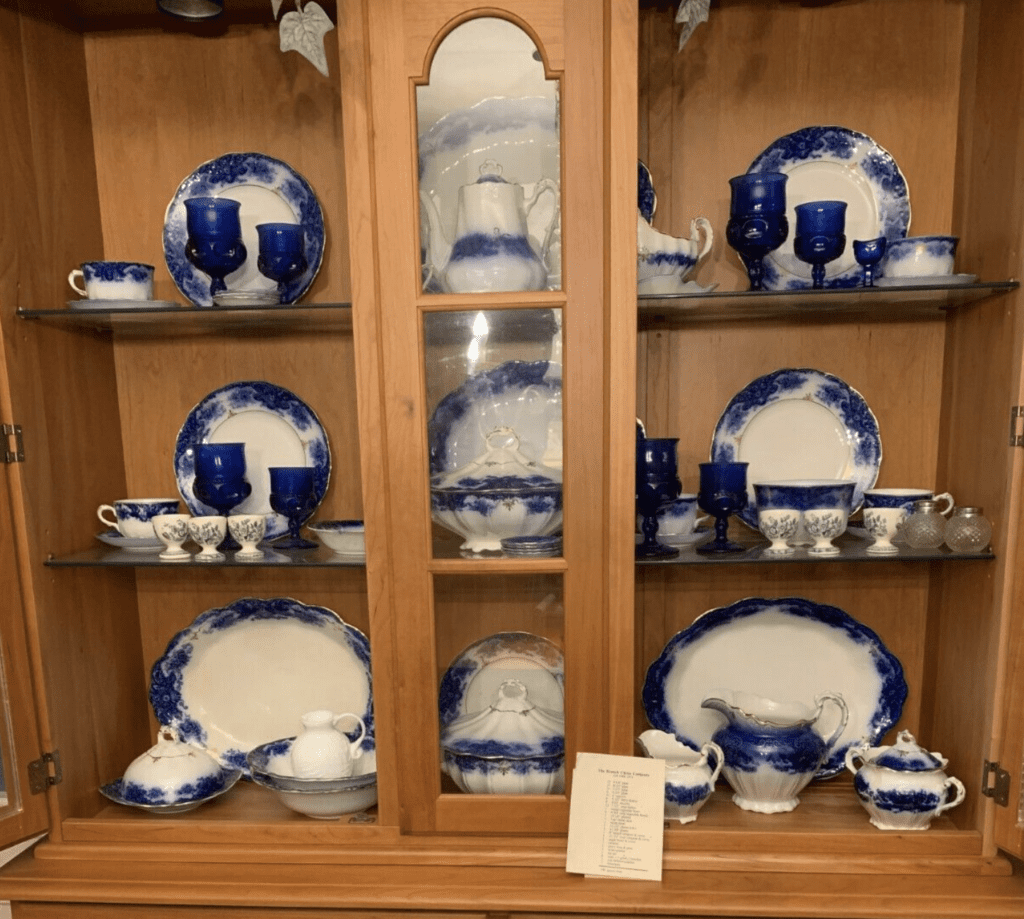
What is the Difference Between China and Porcelain?
Before we get into the nitty-gritty of Flow Blue china, we need to make something clear: china and porcelain are essentially the same things. While there are different kinds of china and porcelain, they typically refer to the same product. (Source)
The term “china” became common because porcelain was often imported from China back in the day. Both terms usually refer to fine dinnerware. Below we will use the two terms interchangeably.
The History of Flow Blue (Where it’s from and How it’s Made)
The origin of Flow Blue china is almost mythical for antique history: nobody seems to know for sure how Flow Blue china began. Some claim that it was a purposeful means of decorating china, while others purport that it was a manufacturing accident that caught on in the market. Here, we look at what we do know about the origins of Flow Blue.

In the early 19th Century, manufacturers in England were trying to recreate famed Chinese porcelain that was extremely popular with the upper class at the time. They were using a newly developed technique known as “transfer decorating.”
Traditionally, every piece of quality Chinese porcelain was painted by hand in China before being shipped to England and other areas of the world. However, English manufacturers wanted a more efficient means of decorating china, so they developed transfer decorating.
Transfer decorating allowed for mass production of a design. It was accomplished by first engraving a metal plate (normally copper) with a design. After this, the plate was then covered in paint while warm. The plate would then be cleaned with a palette knife and a special cloth called a boss.
At this point, a piece of tissue paper was carefully placed on the painted metal plate before being transferred to the new plate. Next, the design was rubbed into the plate before being placed in water, allowing the tissue paper to naturally float off. Once removed from the water, the plate was then dried by heating the plate. Finally, the plate would be dipped in glaze and fired, just like any other piece of ceramic.
This more efficient means of decorating allowed English manufacturers to produce china in larger quantities. However, it did come one with one bump in the road: the paint on this porcelain was being smeared in a way that traditional Chinese porcelain did not.
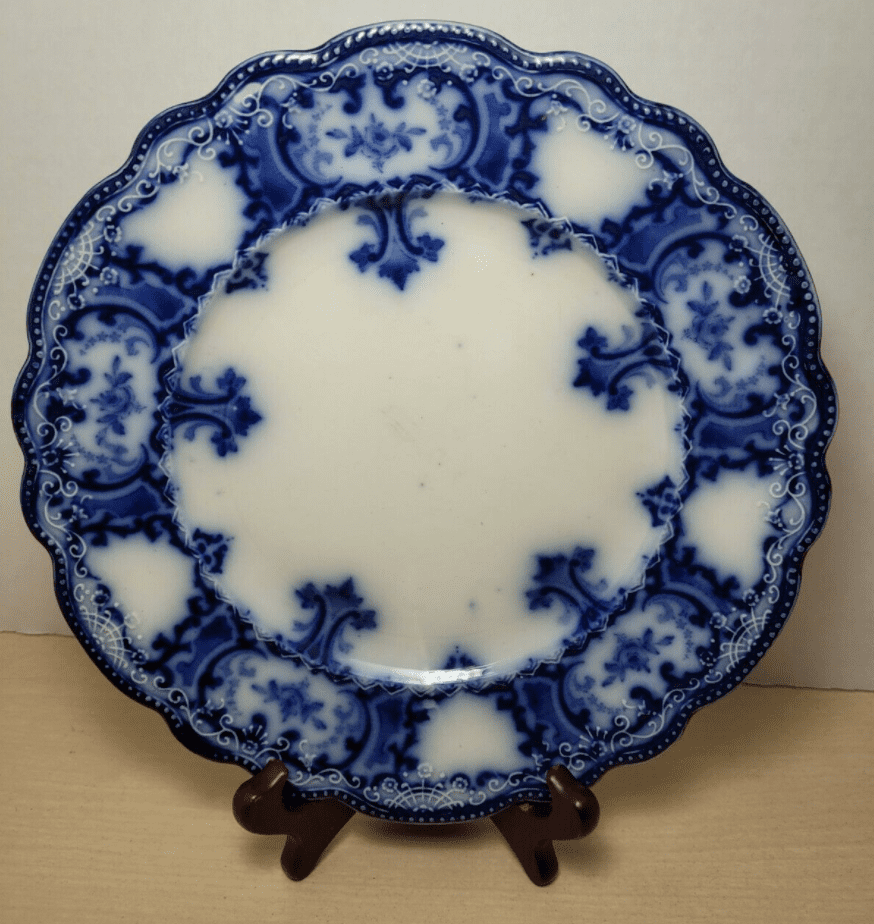
Manufacturers noticed that the smearing occurred when either lime or ammonia chloride was added to the manufacturing process. While some of the upper class in England considered this “flow” evidence of cheap china, it caught on with the middle- and working classes who could not afford the highest-quality imported china, and also became popular in the United States.
Flow Blue china had its highest rate of production mostly from the mid-1800s to the 1920s. It became less popular as graniteware and other types of pottery became more affordable. Today, it is considered an antique due to its unique design and high popularity throughout the late 19th and early 20th centuries.
Why is it Blue?
When Flow Blue was first beginning to be manufactured, it was designed to mimic the Chinese porcelain that was being imported. All of the Chinese porcelain at this time was blue, so English manufacturers sought to imitate this.
Though they used different methods for creating the china, they worked to make it appear as similar to the Chinese porcelain as possible. Additionally, blue from cobalt was the only color that they were certain would survive the glazing process. The use of cobalt is what gives Flow Blue china its distinct blue color.
What does “Flow” Mean?
What makes Flow Blue china unique is the flow. There is a lot of china that is designed with blue colors, as much of the china being produced worldwide at this time was also blue. However, it was the English’s unique manufacturing process that created the Flow Blue that makes this china unique.
Flow is the smearing or blurring of the blue that occurs when ammonia chloride or lime is added during the manufacturing process. It’s difficult to describe the appearance in words, but this flow occurs because part of the blue paint is blurred onto the undecorated white areas. This gives the white area surrounding the blue paint a bluish tint or hue that is distinctive to this kind of china. (Source)

There is some debate on whether or not this was accidental or purposeful. It’s possible that it was a manufacturing incident that gained popularity, and manufacturers decided to roll with it. This is perhaps why it is unclear whether or not it was an accident: marketing a piece of “fine dinnerware” as an accident is not a good marketing scheme.
Marketing it as a purposeful artistic choice makes it appear more intriguing and fanciful. Whatever the case, manufacturers chose to continue with mass production of the Flow Blue china, making it easily recognizable even in modern times.
Is it Flo Blue or Flow Blue?
As with most antiques, Flow Blue has gone by different names over the years. Flow Blue is what has really stuck, although it is sometimes written as “Flo Blue” or “Flown Blue.” While all of these will get you to the same place, and none is technically wrong, the most technically correct of these is Flow Blue, as the word Flow comes from the flowing of blue into the white that is characteristic of Flow Blue.
Does Flow Blue China Contain Lead?
Lead oxide is a common ingredient in glazes for porcelain. Though initially considered safe when prepared in the right way, recent debates concerning the safety of even minimal amounts of lead oxide in porcelain and other materials have arisen.
While there’s no way to guarantee the presence of lead in Flow Blue, much of it was likely made with lead oxides. Though you won’t notice it immediately, there is a small chance that the trace sources of lead oxide could be potentially harmful long-term.
How Much is Flow Blue China Worth?
Maybe you’re so intrigued by the article up to this point that you’ve decided it’s worth investing in some Flow Blue to have for yourself. Or maybe you’ve stumbled across some old Flow Blue and you want to know its actual value. Either way, knowing how much a piece of Flow Blue china is worth is important for both buying and selling.
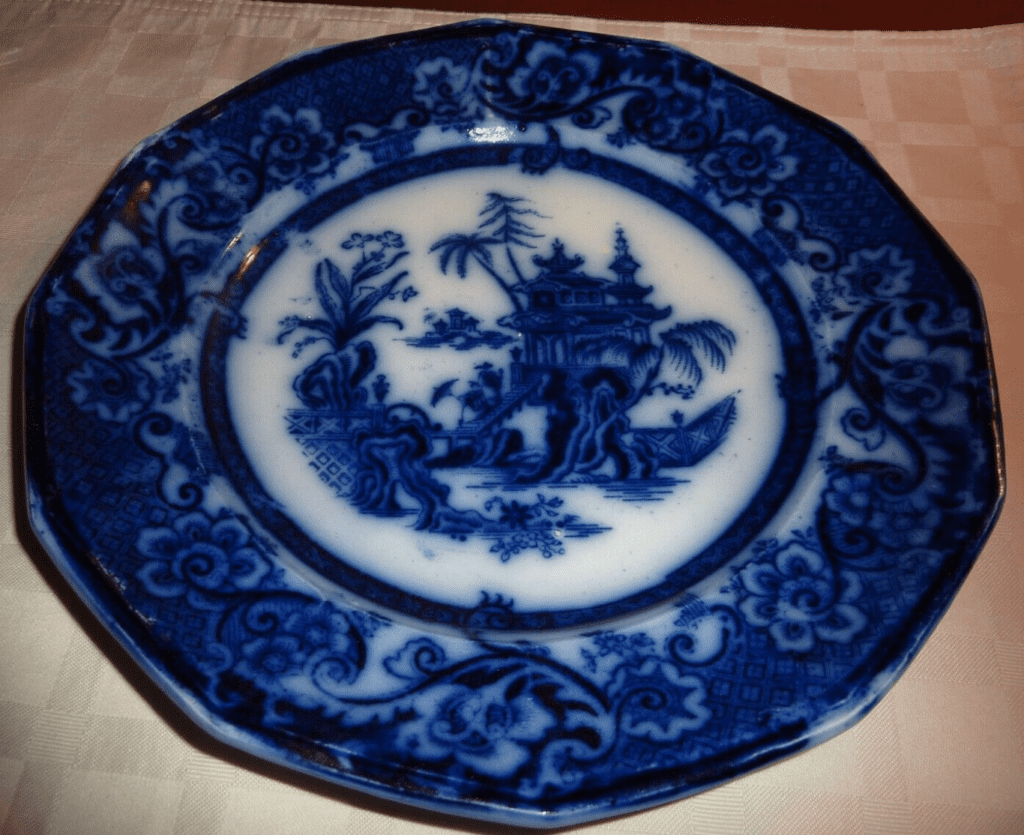
The value of any antique will fluctuate based on several factors, including but not limited to: the condition of the piece, the origin of the piece, and the rarity of the piece.
Condition. When it comes to antiques and collectibles, having a piece that is undamaged or in peak condition is priceless. Check the piece you’re buying/selling for any kind of damage, including chips, cracks, scrapes, fading, or any possible damage. If you have a piece that you plan to use, be extremely careful not to allow even the smallest crack, as any damage will cause the value of a piece to drop dramatically.
Origin. The origin of a piece refers to when it was produced. Blue Flow china is still produced today, albeit in smaller numbers than in 19th century England. While a piece that was produced recently is not particularly common, its value will only ever be the value of buying it directly from the manufacturer—or less, because it will be used.
On the other hand, obtaining an (undamaged) piece of Blue Flow china from the early 19th century when it was first being produced could make it an extremely valuable piece. Older pieces increase in value as time passes because they become more difficult to find, and there’s a certain value in having the original of something and not a reproduction.
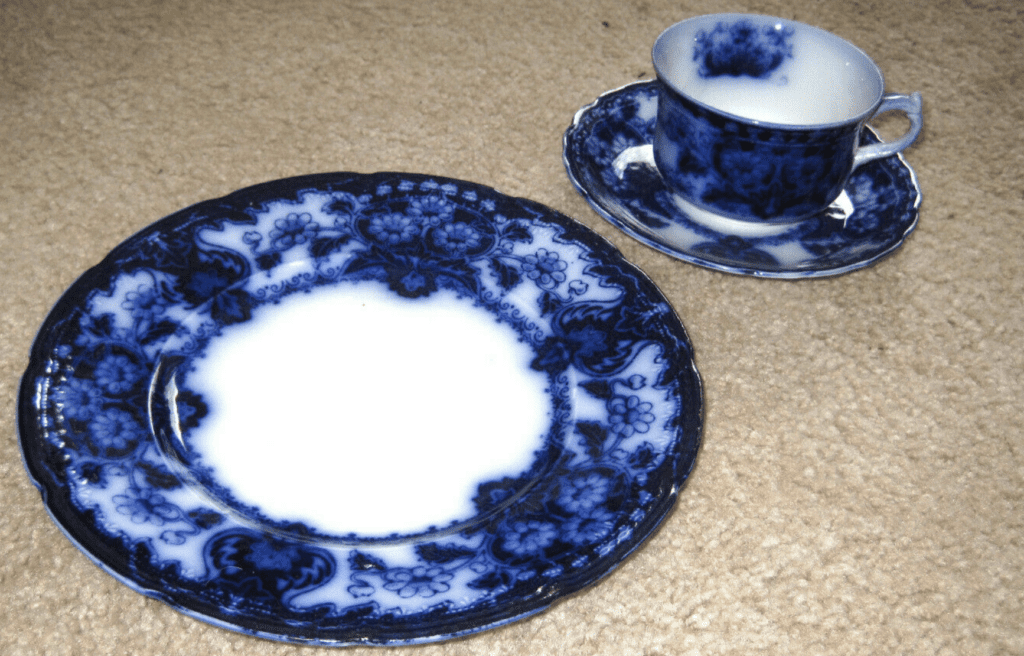
Rarity. Rarity is related to originality but differs slightly because it considers the design or style of the piece in question as well. Rarity refers to how many or how much of something there is. The less common something is, or the fewer there are, the greater its value. Originality is related to rarity because older pieces tend to be less common, but certain pieces and designs are more valuable than others simply because they are rarer, no matter when they were produced.
How can you know if you have an original or rare piece? You can start by doing a simple Google search of the manufacturer and the design. Describing the design could be effective, though it might require some research.

To delve deeper into the value of your Flow Blue china, some books can help you identify the type of Flow Blue that you have. It also might be a good idea to consult a trustworthy expert in antiques or Flow Blue china specifically. Antiques can be extremely valuable, and some people are ruthless, so be wary when it comes to buying and selling Flow Blue china.
Prices on antique Flow Blue will typically range from about $50-$500. Anything beyond that is an extremely rare collectible.
How to Identify Flow Blue China
Being able to identify Flow Blue china is important when determining the value. There are a few tips and tricks you can use to help identify your Flow Blue china. You’ll want to know the design, the manufacturer, and the year it was made, if possible. One of the most important distinctions to make is knowing if your Flow Blue is an original or a reproduction. Many styles of Flow Blue china have been reproduced over the years, and may even currently be in production. An original will always hold more value than a reproduction.
Original pieces tend to be fully glazed while reproductions tend to have an unglazed bottom rim. Reproductions also tend to use different-colored blues (giving them a greenish or inky blue), while most originals have a striking cobalt-blue color. Finally, the original maker’s marks tend to be smaller than reproductions, with originals being around 1 inch wide, while reproductions tend to be closer to 2-3 inches wide.
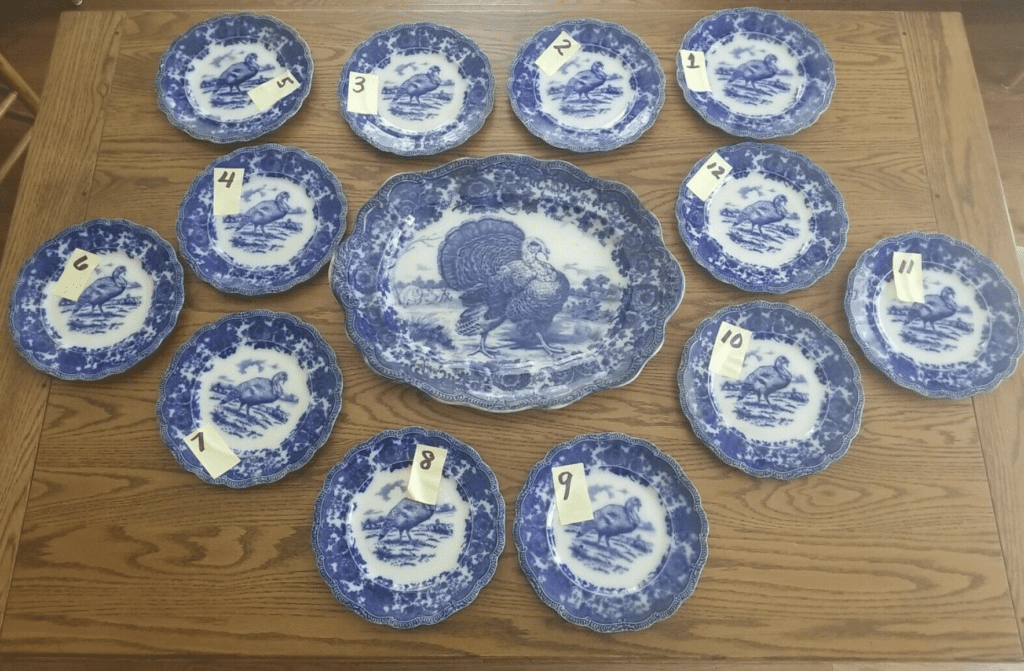
Googling the manufacturer (if marked on the back of the plate) can lead to a wealth of information, as can Googling the design. This may not, however, reveal all of the information you may want, so a deeper dive might be necessary. There are many resources to go about doing this, such as books, experts, and even reproduction stores. You might be surprised at how much you can learn about an original piece by studying a reproduction!
Flow Blue China Design
While each piece of Flow Blue china is unique, there are a few stylistic elements that tend to guide the identification of designs. Flow Blue china design is typically split into three separate periods.
- 1835-1860 (sometimes called “Early Victorian”). The early years are characterized by pieces that seek to imitate Chinese design. Thus, oriental patterns are more common during this period. Pieces were also more densely colored, with entire pieces being almost completely covered by deep, dark blue.
- 1860-1879 (or “Middle Victorian”). These years denote a shift to floral patterns and include more Japanese motifs. During this time, color and gold embellishments were also added to enhance designs. Pieces became less densely colored, though the cobalt blue is still striking in these pieces.
- 1880-1900’s (“Late Victorian”). Colors became slightly sharper and clearer as manufacturing practices changed slightly. During this period, pieces continued to be less densely colored, and Romantic scenes (depicting nature scenes and small towns) became more popular.
Note that the dates here are more guidelines than exact dates; production of different styles continued throughout each period.
How to Care for Blue Flow China
Whether you have a classic piece of Blue Flow or just an average dinnerware set, understanding how to care for dinnerware porcelain is an important skill. It’s a skill that’s going out of style with modern dishwashers and the decreasing popularity of china. You’ll want to know how to care for Flow Blue in case you ever come across it.
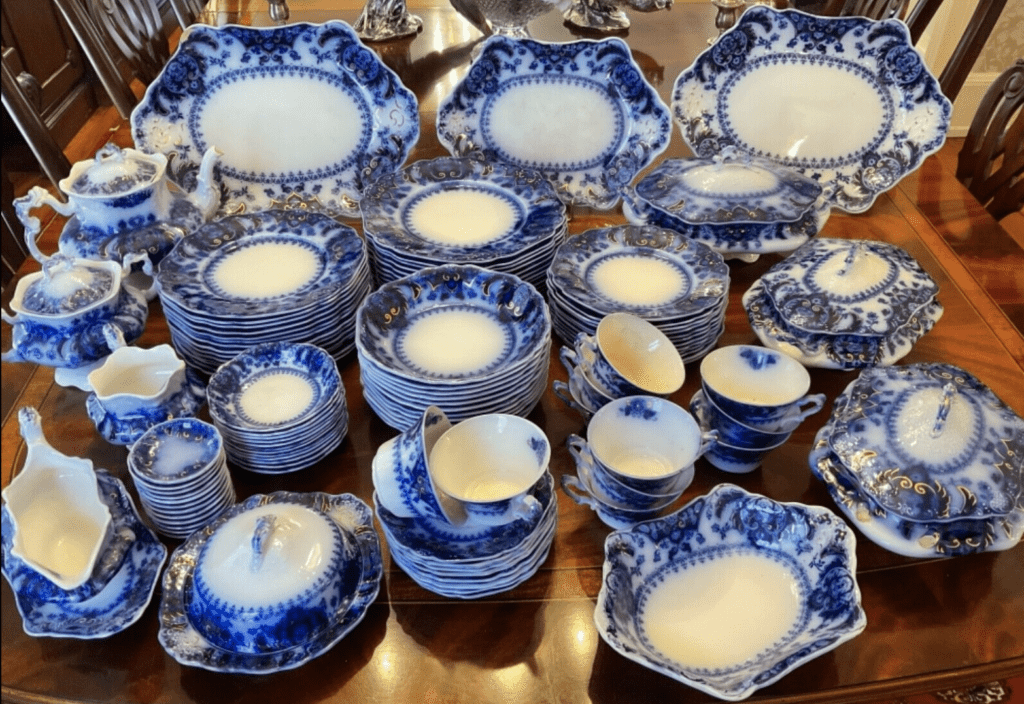
Rule #1 of caring for china: Do not attempt to wash china in the dishwasher. China must be handled with great care, and dishwashers subject china to high pressure and high temperatures. Instead, hand wash your china with a mild detergent (emphasis on mild—you don’t want to peel off any glaze or paint). Use warm and cool water, avoiding hot and cold extremes. China will be much easier to wash if it is washed immediately after eating, and not allowed to sit and dry, especially overnight. The sooner you can wash your china, the better.
Any time you’re going to set china down, seek to place it on a soft surface: some people even recommend putting a towel in the bottom of your sink so there’s no risk of cracking it while washing. Be careful with the tap and edges of the sink, as these can cause cracks and chips with even the slightest of bumps. You might also consider removing other silverware and any rings you might be wearing to avoid scratches and paint removal. Finally, when storing, consider placing a small soft cloth or paper towel between pieces.

